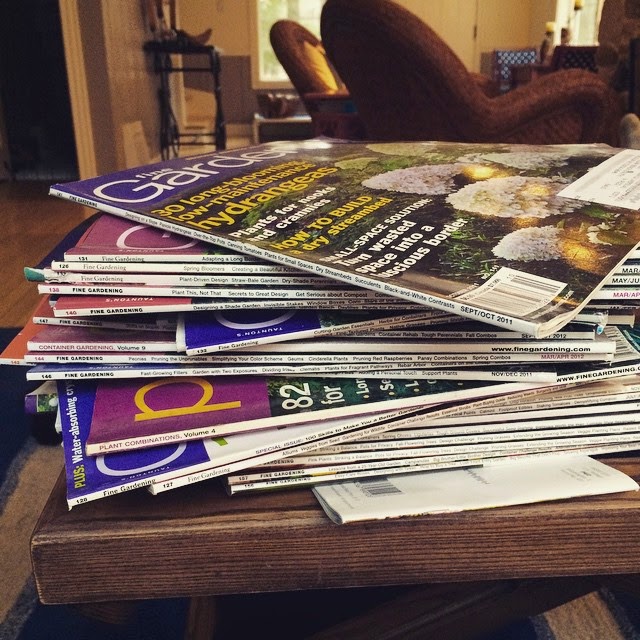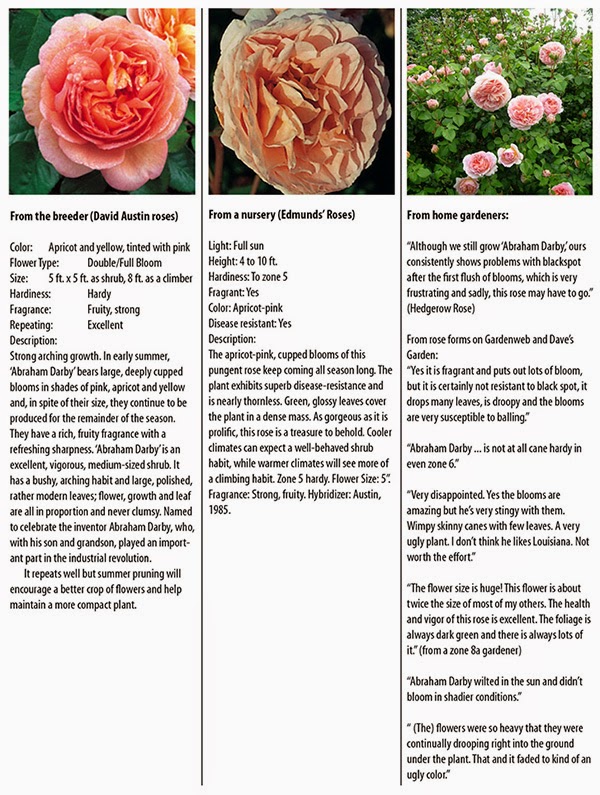I used to just go to the garden center and buy whatever struck my fancy that day. Sending a gardener to a nursery on the first warm day of spring is like sending someone on a starvation diet to the grocery store. It’s not going to end well.
But in recent years I have gotten so much better about researching plants before I buy them. This is particularly true with more expensive plants and that only makes sense. A few years ago I made the mistake of coming up with a long list of well researched plants and then spending weeks trying to find them at a local nursery. Fortunately, at least two of the nurseries I like now publish lists of most of their stock, so I can narrow down cultivars depending on what I can pick up locally.
For smaller plants I can order online and I have had great success with most of the plants I’ve purchased this way.
As I research via the Internet, books and my foot-tall collection of old Fine Gardening magazines, I make a list on my phone so I always have it with me. You never know when you’re going to be at a nursery that might have what you’re looking for.
How I go about researching a plant depends a bit on where I plan to buy it. If I’ll be buying it locally, I try to start with nursery-provided plant lists. Some nurseries don’t have their 2015 lists available yet, but if their lists from last year are still on their website that’s at least a good starting place.
If I’m buying online, I start with a nursery I trust either through experience or reputation. I often refer to the Garden Watchdog on Dave’s Garden to find or check up on a nursery.
After I find a plant I’m interested in, I start with a Google image search. It is amazing how different a plant can look in different circumstances. Nurseries often over-saturate the color in photos to make blooms look more vibrant or the color may be different depending on how much sun it’s in. I try to pay special attention to photos by home gardeners or bloggers because I feel like this is a more accurate depiction of how a plant might look in my garden.
If I’m still interested in how the plant looks after I’ve seen more photos of it, I seek out more information on it. You would be surprised at how different exposure needs, size and blooming information can vary for the same plant. I’m wary of information from breeders because they will only provide the information that casts the plant in the best light. Good nurseries are better about providing less flattering information about a plant because it is in their best interest that you do well with plants you buy from them. Bad nurseries (and big box stores, in my opinion) don’t care if the plant lives or dies, they just want you to buy it from them. And some of the most practical information comes from home gardeners and landscape designers (who also have a vested interest in the long-term success of plants).
Here’s a comparison of different takes on a beautiful English rose ‘Abraham Darby.’
I don’t think anyone is going to argue that ‘Abraham Darby’ isn’t a gorgeous rose (and I know plenty of people who adore that rose). But reading reports from actual gardeners (in the last column), offer some pretty interesting tidbits. Several people reported having serious issues with blackspot even when other roses in their gardens were unaffected, even though the nursery says it has “superb” disease resistance.
Other home gardeners reported frustration with its heaving nodding blooms on weaker stems, and there is absolutely no mention of that from either the breeder or the nursery. As a zone 5 gardener, the first thing I look for in a plant is hardiness and while many sources claim ‘Abraham Darby’ is hardy to zone 4 or 5, the report from at least one gardener that it is not CANE hardy in zone 6 is cause for major concern. There is a difference between plant hardiness (meaning the plant won’t die in winter) vs. cane hardiness (meaning the canes won’t die back in winter. If a rose isn’t cane hardy it will have to regrow every year, meaning that it will not be nearly as big as it otherwise would be. It also means that it’s not suitable as a climber.
Of course reports from home gardeners on the Internet have to be taken with a grain of salt. There’s really no way to know if that person knows how to grow anything, or what the conditions are like in their yard or if they remembered to water it.
But if you can find a local gardener who you trust and you are confident knows their stuff, then that’s as close as one can get to the real facts. I’ve been searching for a new climbing rose for the front of the house (yes, I swore off roses—again—last year, but I lied—again) and after scouring the Internet and even asking readers and friends, I was pretty confused. I ended up having a wonderful email exchange with a fellow local master gardener who is a true rosarian. He came up with a great suggestion: ‘Autumn Sunset.’ We’re going to get together this week to talk more about it, so that could still change, but I’m certain I’ll get better information from him—someone who grows roses in my area—than most places I could look.
I’m not suggesting that hours of research has to go into every plant purchase you make. One of life’s true joys is going to a nursery and just picking up something because it interested you. But that’s something I only do with plants of a certain cost and ease of care. If I have to spend a lot of money or time babying a plant, I want to make sure that I choose the correct one from the beginning. Too many gardeners get discouraged because they can’t grow X-plant (fill in your favorite plant failure there), when it’s quite possible they may not have chosen the correct cultivar in the first place.
Take advantage of these long and torturous gardening-free days to do the research you won’t have time for once spring has come and you’d rather be in the garden.





4 Responses
I have to say that I hate 'Abraham Darby' as well. I haven't had a terrible black spot problem with it, but those spindly stems are just a deal breaker. I finally dug it out and put it on the burn pile last year. Good riddance.
Thanks for this post. It seems I use a process very similar to yours when looking and deciding about plants. I love doing online research….Amazon for books and the best source for plant research….Annie's Annuals and Perennials.com They have mail order sales, but I am so fortunate to live just about 20 minutes from the nursery. SO many great points – they propagate and sell lots of plants not typically found in garden centers, the staff is knowledgeable and friendly, and when you browse their site you can make a wish list of plants they may not currently have availible and they will send you an email when they have it. When I read or hear about a plant new to me I always check Annie's and Dave's. They are my backup!
In the pre-Internet era, I used to make lists of plants and cross-reference prices from different nurseries. I still do some of that online but now that I am looking for more unusual things, price isn't always the first concern. As for roses, I have had pretty good luck with rubricolia and an old-fashioned, fragrant double white, R. Alba plena. Best rose ever was growing at our first house and I wasn't smart enough to take a cutting. It was a trouble free fragrant red climber. I learned my lesson the hard way!
Love the idea of comparing information on the websites, Erin.